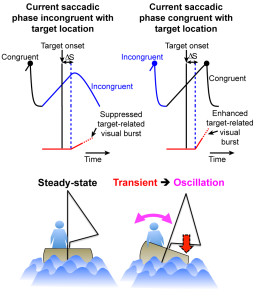
We have a new and exciting paper in press at the Frontiers in Systems Neuroscience Research Topic on Perisaccadic Vision.
This is the second in a series of two papers that we have in this special issue of the journal. In these papers, we explored the experimental and theoretical implications of the existence of peri-microsaccadic changes in perception.
The current paper asks a compelling question about peri-microsaccadic changes in vision: are these changes substantial enough to contribute to the interpretation of results of experiments in which microsaccades occur, or do they just have a minor modulatory influence? We developed a minimalist model of task performance that only invokes peri-microsaccadic changes in spatial cueing paradigms. The interesting result was that this model was sufficient to simulate spatial and temporal dynamics of performance changes in these cueing paradigms. Thus, Â peri-microsaccadic changes can theoretically have a substantial impact.
We also tested important experimental predictions of the model, and we investigated why microsaccades might happen during cueing paradigms in the first place. It turned out that the primary goal of microsaccades is to optimize eye position on the fixated target. Peripheral cueing simply transiently perturbs such optimization, much like how a sudden gust of wind might transiently perturb the stance of a sailor trying to optimize her stance in a small sailboat.
This work is part of an interesting collaboration that we have with Prof. Masatoshi Yoshida from the National Institute for Physiological Sciences in Japan.
